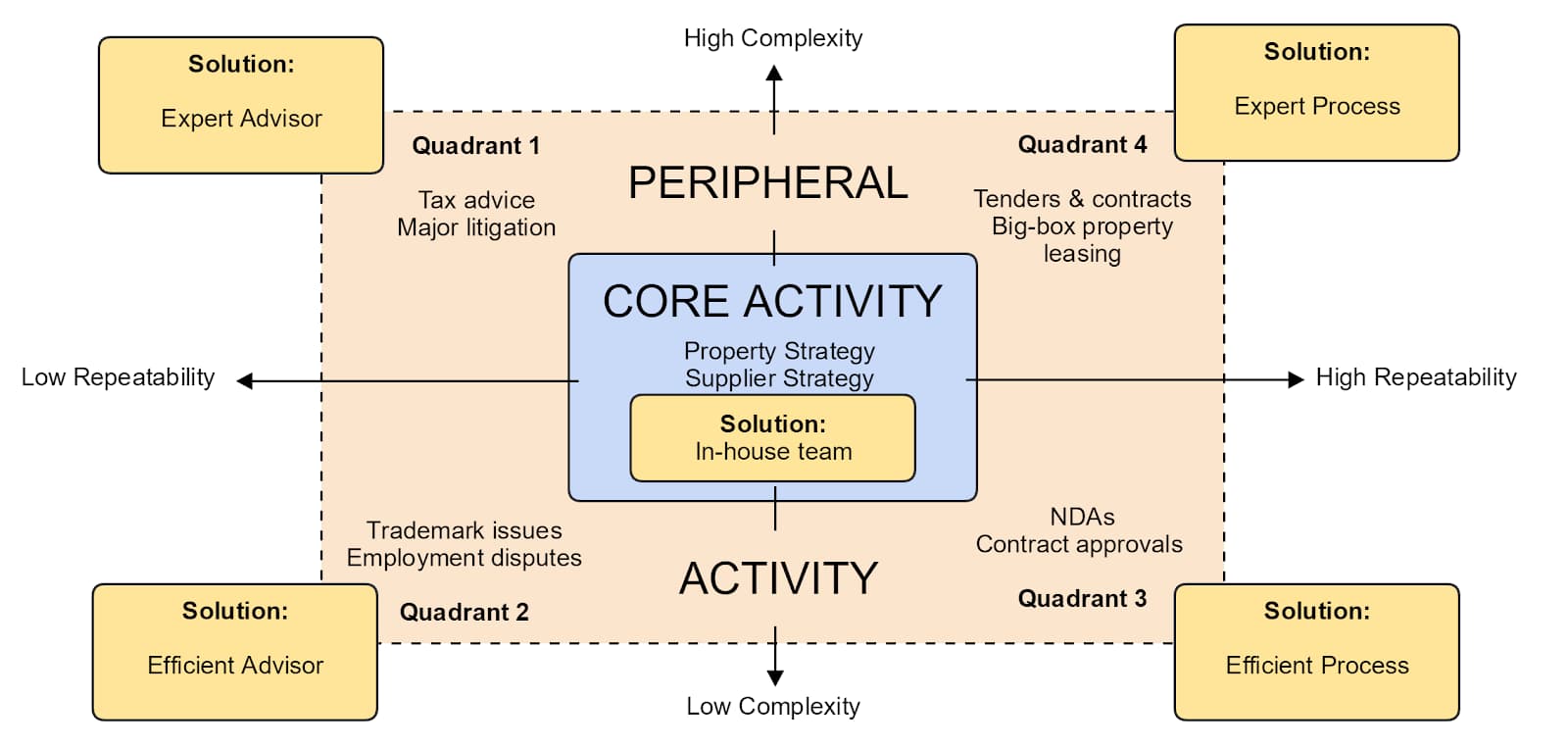If you are an in-house lawyer, your team might face an ongoing pressure to cut legal spending. As explored in Part 1 of this series, your team can achieve this by re-aligning the focus of the legal function with core business objectives. Narrowing the focus to core activities doesn’t mean that the secondary, ‘peripheral’ legal activities of an in-house team simply fall away. Although peripheral to core business objectives, these activities are still needed for the business to function. In this article, we explore how in-house teams can use the ‘core/peripheral matrix’ to re-think peripheral legal functions. With this matrix, your team can identify the best tools for managing these activities while not detracting from core deliverables.
What Is the Core/Peripheral Matrix?
Not all tasks of in-house teams are created equal. Different tasks:
- might require esoteric black letter expertise;
- might require large teams;
- can be completed by non-lawyers; or
- should never end up with the in-house team in the first place.
Being able to quickly identify what each task requires is important in determining how your team should allocate resources. The core/peripheral matrix is a valuable tool used by some in-house teams to tackle this challenge. This matrix involves plotting each task against two axes:
- complexity; and
- repeatability.
By plotting tasks on this matrix, your in-house team will be able to identify the most appropriate solution for each category of peripheral tasks.
Returning to the hypothetical example in Part 1 of this series, A-Star Company’s key objective is to out-compete other retailers. They do this by reducing the costs of products and decreasing the time it takes to acquire new stores. Set out below is an example of how this retailer’s in-house team might use the core/peripheral matrix to categorise its activities.
Let’s delve further into each part of this Matrix.
The ‘Complexity’ and ‘Repeatability’ Axes
The ‘complexity’ axis concerns the variability of the potential outcomes for certain tasks. It also looks at the specialist knowledge that is required to navigate these outcomes. ‘Repeatability’ looks at both the volume of the activity within the business and how similar each unit of activity is to the next.
The focus on complexity and repeatability rather than ‘risk’ and ‘value’ is important. The matrix intends to identify solutions. While ‘risk’ and ‘value’ can outline whether an individual task might merit a solution, they don’t tell us much about what that solution might be.
Take ‘value’ as an example. A million dollar contract can be incredibly simple, whereas a contract for no dollar value can be a minefield. Without knowing how complex or common these contracts are, an in-house team cannot identify the best solution for managing this task.
Continue reading this article below the formCore Activities
Whether or not an activity lies in the ‘core’ portion of the matrix depends on the strategy of your in-house team.
Periphery Activities
An activity will move from the core to the periphery when:
- it does not align with core business objectives;
- the in-house team does not have the capacity to undertake the activity; or
- the in-house team does not carry that specialist capability.
Moving these activities into the ‘periphery’ promotes more effective decision-making on how to approach each task. This does not mean that the in-house team never completes peripheral tasks. Rather, if an activity sits within the ‘periphery’, any assistance from the team should not involve diverting resources from the ‘core’ priority tasks. The in-house team can still have a role to play, but they are only one of a range of possible solutions.
Identifying Solutions for Each Quadrant
When plotted across the two axes of ‘complexity’ and ‘repeatability’, the peripheral tasks of an in-house team can fall into four quadrants. Each quadrant will lend itself to a different solution.
| Quadrant 1: Expert advisors | Highly complex tasks with low repeatability require expert knowledge. It is difficult for most in-house teams to carry such specialised capability internally. With these types of tasks, you should spread the risk by engaging subject-matter experts. |
| Quadrant 2: Efficient advisors |
Activities that occur infrequently and are not highly complex don’t require highly knowledgeable experts. However, they do call for additional capabilities that do not exist within the in-house team. The best solutions for this quadrant are ones that leverage economies of scale by conducting the same categories of tasks across multiple businesses. This ensures efficiency and cost-certainty. |
| Quadrant 3: Efficient processes | Where work is not very technical but happens at a high volume (such as tasks involving administrative box-ticking), the best solution is one that invests in efficient technological processes. |
| Quadrant 4: Expert processes | Activities within this quadrant are best solved by a combination of expert lawyers and an efficient process (such as the solution provided by LegalVision’s managed legal services model). A well-designed technological legal process can improve efficiency while involving legal experts at critical touchpoints in the process. This will help to account for the complexity of particular tasks. |
In-house teams can manage peripheral tasks across all four quadrants is through a clearly structured legal services panel. Here, various suppliers account for the different needs of each quadrant. This process allows in-house teams to carefully select the best solution for each peripheral task.

An essential read for any lawyer interested in the future of law, this white paper covers a breadth of NewLaw topics including legal tech trends, benefits of legal process design, the future of legal outsourcing, case studies on smart contracts and key developments for NewLaw players.
This report will help lawyers and law firms navigate the NewLaw landscape.
Key Takeaways
The core/peripheral matrix is a valuable tool for in-house teams to identify ways to manage tasks. By understanding where each task lands on the matrix, in-house teams can better navigate the legal market and identify the most appropriate providers. Implementing tailored solutions for peripheral in-house activities, your team can maximise its impact without blowing out legal spend. If you have any questions about how your in-house legal team can better meet business aims, contact LegalVision’s Legal Transformation lawyers on 1300 544 755 or fill out the form on this page.
We appreciate your feedback – your submission has been successfully received.












